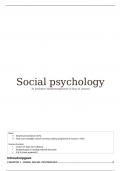Summary
Summary Social Psychology
- Course
- Institution
This summary contains the slides supplemented with your own notes (present every lesson) and if necessary terms self-explained. This document contains all the learning to pass social psychology.
[Show more]



